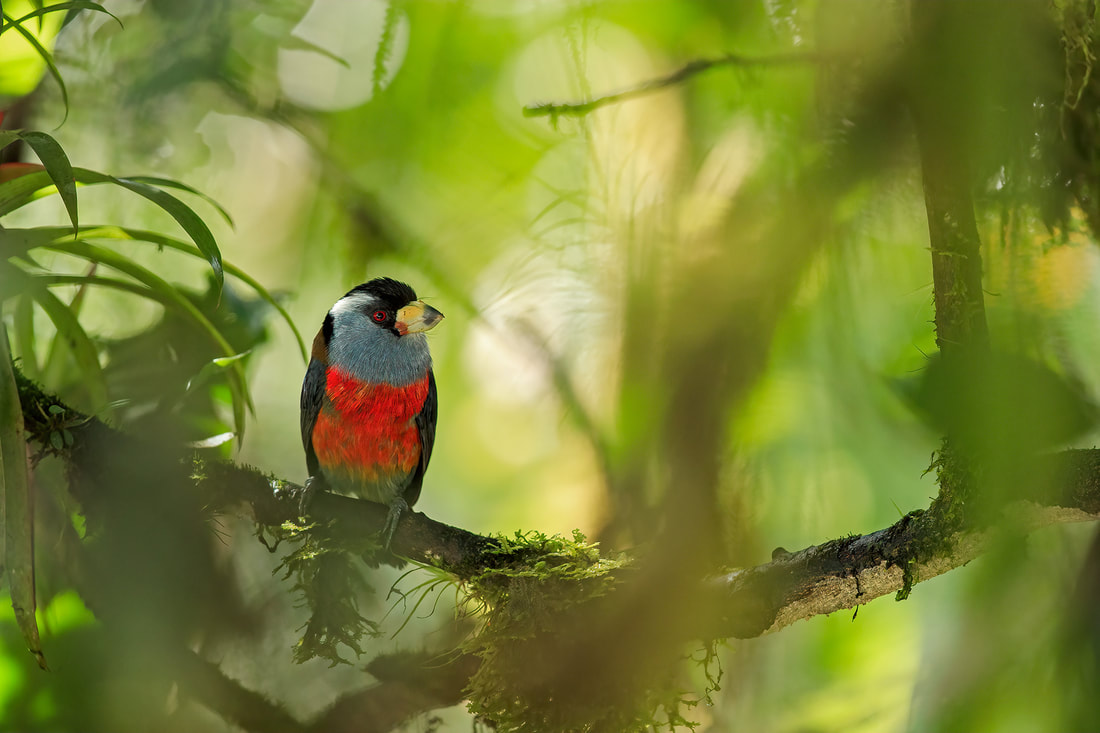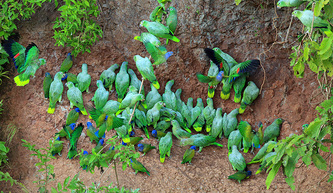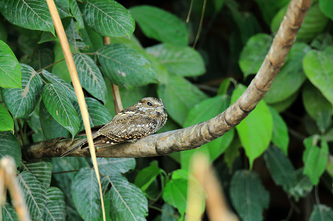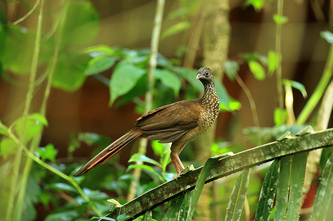|
It seems like things are slowly returning to normal for those who work in the wildlife travel industry. With things continuing to look up, I was delighted to be at the helm for Wildlife Worldwide's Colombia Bird Photography tour. We flew direct from London to Bogota and then on to the city of Cali across the central Andes in the Cauca Valley. It is important to note that Colombia is home to more birds than other country on Earth and the photography opportunities my group were treated to, were quite simply exceptional. I am going to share some of my images from the trip, spread across a few different instalments. I feel this is the only way to do this amazing country and the spectacular birdlife justice. On our first day, we spent a few days around the lodge's grounds and were blown away by the number of hummingbirds, tanagers, woodpeckers and even toucanets. The next day we moved across the mountain, high above the city of Cali where we hoped to photograph the elusive scaled antpitta and the massively sought-after multi-coloured tanager (see below). For our third day of bird photography in the Western Andes we headed to a known spot for toucan barbet. Here we were treated to some more incredible photography and the whole group just lapped it up. These stunning birds were all photographed over a period of three days in Colombia's Western Andes. I was using my Canon 1DX II with my Canon 500mm f4 L IS II USM lens.
Keep your eyes peeled for the next instalment and be sure to find out more information about the tour on the Wildlife Worldwide website. N.B. I will not be leading the 2023 departure for this tour as I am away in Brazil, leading for Wildlife Worldwide.
0 Comments
After a very busy summer leading trips all over, exhibiting at Birdfair with Wildlife Worldwide and prepping for the next few months, it was time to take a bit of me time. Of course, when you are a wildlife photographer, that means going in search of some incredible wildlife – so my girlfriend and I headed off to Uganda for a trip of a lifetime. Uganda is best known for its primates and that was the major draw for us too, particularly the mountain gorillas of Bwindi Impenetrable National Park in the south west of the country. We had booked to stay at Buhoma lodge and I can honestly say that it was one of the very best places I have ever stayed. The lodge itself is situated in the rainforest so don’t expect super luxury, but it is spotlessly clean and the service is superb. On the morning of our trek we headed down to the registration office, accompanied by Ivan (from Buhoma) who sorted everything out for us and listened to the briefing. We had to drive around the mountain to start our trek and were to be going in search of the Habinyanja group, with Makara the silverback as the head of the family. Our trek started off in the tea plantations of the surrounding villages before we reached the boundary of the forest. What happened next was one of the most incredible experiences of my life and I have been very privileged to see some pretty special things. The gorilla group was only around 150 yards inside the forest but this involved a very steep descent into a river gully and back up the other side. This was not particularly demanding and took less than an hour to negotiate, a lot less than we were anticipating, but that is the luck of the draw sometimes. The first gorilla we saw was an adult female who was fast asleep, she was no more than 5 metres away and didn’t even open her eyes as we stumbled through the thick vegetation. I genuinely couldn’t believe what was in front of my eyes. It was completely surreal to be so close to such a remarkable, wild animal. Some 30 metres further down the slope was the silverback and his family were strewn across the vegetation between us. The next hour of my life flew by and a lot of the time I didn’t even take any photos, I was just mesmerised by the majesty of the moment. I really focused my efforts on the youngsters of the group who provided some of the most wonderful moments and at times were less than 30 centimetres away from us. The following images really don’t do it justice, but I hope it at least gives you an idea of what we were treated to. I will just finish by saying that if you have not yet had the opportunity to visit Uganda (or Rwanda), then I really can't recommend it enough. It is one of the most incredible things you can do in life, a genuinely life-changing experience beyond anything you can ever imagine ... book your place now!
So after a frog bonanza in Queensland, we spent 3 weeks travelling back down south towards the northern areas of New South Wales. Along the way we came across a wide range of Australian critters ... and to make a nice change, even a few mammals. Including one that I have wanted to see in the wild for as long as I can remember, the incredibly elusive Platypus. We visited Eungella National Park in tropical Queensland, where we had heard there was a relatively good chance of seeing these unique and intriguing mammals. As you may or not be aware, the Platypus is only one of two monotremes that still exist on earth today. The classification for a monotreme is that they are an egg laying mammal, the other species which features in this unusual family is the Echidna. The Platypus is even more bizarre than just the fact that it lays egss, it also leaks milk through its skin and even has poisonous spurs on its hind legs. Anyway ... here are the results of this little expedition As you can see from the two very different styles of image above, I had two separate sightings. In fact, we had 3 separate sightings of at least 5 individuals. Our first sighting was as the evening light was fading and we were waiting above a beautiful isolated pool, within twenty minutes we saw a splash and a bow wave ripple on the water. It was my first ever moment watching a wild Platypus and something that will remain with me for a very long time, it was magical. We re-positioned ourselves and waited , hoping that we would get an even closer encounter.
On the second day we went back but not until later in the morning. Platypus are primarily crepuscular and it is very unusual to see them during the heat of the day. However, we were in luck, the second two images are both taken at 11 am and was swimming within 5 metres of us. It was such a magical experience and one I will never forget. The third day in the Amazon Basin and another early start, this time I was heading to the famous 'clay licks' on the Napo River. These are muddy cliff faces along the river bank, where large numbers of Parrots come to feed on the soil. First though, we had to head across the black lake and a short walk through the forest to get to the motorised canoes. When we arrived at the river side of the lake, we were greeted by a tell tale crashing sound in the canopy. There, above us, were a huge group of Squirrel Monkeys, undoubtedly the same group as we saw upon our arrival to the forest, and joining them were a group of White-faced Capuchins. They 'monkeyed' around for a while but we couldn't stay long, we were on a mission that had a time limit. After our morning monkey fix we quickly made our way to the motorised canoes on the banks of the Rio Napo. After around a 30-minute ride down the river, we arrived at the large clay cliff where we would not have to wait long for our feathered friends. The noise was what you notice first, a constant noise which can only sound like a group of parrots together. They chatter among themselves, until one builds up the courage to leave the safety of the trees and expose themself on the bare cliff face. The parrots have to come back every few days, a wide variety of species are reliant on these clay licks to ensure that the minerals in the soil counteract the naturally occuring toxins in their diet. If they couldn't get these vital nutrients then they would not survive. Occasionally the odd Boa Constrictor ambushes the birds as they fly to the cliff face and this is why they are particularly nervous and flighty. We we were quickly in luck with a variety of different species feeding on two different parts of the bank. Mealy Amazons making up most of the numbers but Dusky-headed Parakeets providing plenty of vocal support. We next visited the inland 'cave' parrot lick of Napo Wildlife Centre, this was around a half an hour walk into Yasuni National Park and a sit and wait affair. The noise again was staggering, particularly as the birds surround you in the trees above, you know they are there but you just can't see them. Gradually they come lower and lower until one brave individual decides to break cover and starts to carve off small slices of clay which it eats as if it were food. Have a look at the video and you can hear the noise for yourself! After a long day out and about around the forest and spending time around the clay lick on and off up until lunch, it was time to head back to the lodge and try my hand at a bit of afternoon macro photography. However a very unexpected visitor ended up altering my plans somewhat. I practised my macro photography as I was meant to be running a workshop there later on in the evening, and having found some good subjects in the shape of spiders and other creepy crawlies I was happy to get some rest. However, on my way back to my room I saw some movement ... As you can see the surprise animal, and now definitely one of my favourite species worldwide, was the Pygmy Marmoset. This is the world's smallest monkey, in fact it is actually hard to describe just how small this monkey is. Let's just put it this way, it would easily fit into the palm of and adult person. At first I only saw some movement on the edge of one of the walkways, I actually thought it was a small bird. It was only as I approached the tree it jumped into, that I realised I had found this amazing little creature. I tried to find others around the lodge so they could also see this tiny primate but they had all gone out on their afternoon activities.
I was very lucky to be completely alone with the little fellow and at one point was no more than 3 metres away, it was actually quite an intimate moment. Two primates of vastly different sizes, checking on another out and seeing what they are about. It seemed just as intrigued by me as I was by it. That was why after the first shot above, the others are in the open, it was quite content to come out in the open and not hide away. What a day it was then ... amazing parrot sightings, a trip down the Rio Napo (a tributary to the mighty Amazon) and the world's smallest monkey hanging about and happy to let me take its portrait. I guess that is the beauty of wildlife, sometimes it ends up coming to you and that makes it that much better! So after my first afternoon in the Amazon I was already and raring to go for my next outing and to see the rainforest proper. It was arranged that I would be heading for the canopy walkway the next morning and so I packed my camera bag ready to go. The main issue being that I didn’t know what I might need, so I took everything … all 16 kg of it! So as you can imagine it was pretty heavy, and with daytime temperatures in the 30s and humidity levels usually well over 95% it was going to be a hard day. I woke up the next morning, heaved the bag onto my back and headed off into the forest with our English speaking guide, Oscar. We stopped every now and then to see things of interest and then we stopped close by to a particular tree and Oscar set up the scope. He spent a bit of time focusing the scope onto a small hole about 60-70 feet up a huge tree. There in the hole were three Night Monkeys, these small primates always return to the same hole to rest during the day so he knew exactly where they would be. After a pretty crappy photo (due to it being very early in the morning and way up a tree) we moved on to the canopy walkway. Wow, wow and wow! What and amazing experience to be above the forest at such a height, seeing the birds and the mammals and just the trees in all their glory. There we saw bird species of which all were new to me, things ranging from tiny flycatchers to the Black Vulture soaring above us. We saw three species of monkey; Red Howler Monkey, Black-mantled Tamarin and Red Titi Monkey. So anyway, enough blabbering, here are the pictures from that morning and some from the afternoon. After a long hard morning, but definitely one to remember, we had a lovely relaxing lunch and some noisy visitors in the form of Speckled Chacalacas right outside my room as you can see above. The afternoon activity was a photographic boat ride around the black lake, the primary focus was meant to be the prehistoric looking Hotazin. This ancient species of bird has remained unchanged for thousands of years and are extremely successful. However on this occasion all the wildlife seemed a little shy and refused to show themselves particularly well. This is when as a photographer you have to try and be a little more imaginative. The herons in the foliage I particularly like for their more artisitc approach of "Animals in their Environment".
The lake and the lodge both made good photographic subjects too. The lodge looked particularly beautiful at night with its warm lighting glowing among the dark forest. The tree frog species you can see, right at the end of the selection of images, came and found us. Whilst sat at the bar in the evening he appeared on the icecream freezer, seemingly enjoying the cold metal and escaping the constant heat even if only for a short while. So my first full day in the Amazon was certainly educational, introducing me to a variety of main species you can encounter, it wasn't a particulaly good day for close views of mammals but the wealth of bird life was obvious to see. The only down side from a personal point of view was that I wasn't really provided with any great photographic opportunities but you have to take what you can get. The rainforest isn't a forgiving place and you have to work really hard to get good images. Perhaps if this was a pure photographic tour it would have been a very different matter. But full credit must go Part 3 has a new favourite mammal and a splash more colour ... so keep reading! So a few weeks ago I was presented with a superb opportunity, “Would you be interested in joining the Naturetrek Wildlife Festival in Ecuador at the world famous Sacha Lodge in the Amazon Basin? On one condition, that you act as a photographic leader and run some photographic workshops?” I was asked. As I am sure you can all imagine it was a tough choice, before I knew it (2 weeks later) I was on a plane flying from Heathrow to Quito. Quito is a historic, Spanish colonial city which is now the Capital of this relatively small nation. The city was really just a stepping stone towards the Amazon basin but I did a small amount of high altitude birding the day before my flight into, what was for me, the unknown.
So after a day to try and adjust to the altitude, Quito is in the Andes and higher than most European mountains, it was time to board an internal flight to the city of Coca. This city was a small community only 20 years ago but the discovery of oil has brought with it an industrial boom to the Amazonian region. This of course has greatly improved the wealth for the Ecuadorian government but it seems the environmental problems could be severe. Anyway, back to the adventure and the treasures that lay in store. We transferred down the Rio Napo from Coca, heading eastwards along the swollen river on a, high speed, motorised canoe. We were dodging submerged trees for the journey’s entirety but that just added to the excitement. After a couple of hours watching the river world go by, we arrived at the landing point for the lodge. Here we had to alight and start a kilometre long walk through the rainforest to a black lake, on which the lodge is situated. As we made our way along the path and the boardwalks we heard some crashing in the tree-tops. To our amazement, after only being in the forest for half an hour, we had our first two species of primate … a huge family group of Squirrel Monkeys and a slightly more secretive family of Capuchins. It was the Squirrel Monkeys that were the stars of the show, they whole group crossed the path we were on using the overhanging trees and at times were only a few metres away. They sat and posed nicely and what really amazed me, was that they looked straight through us. We weren’t even worth paying attention to, as a large group of people we were just a series of obstacles that could be easily avoided by staying up in the trees. Anyway enough of my rambling enjoy the photos!!!! |
AuthorBret Charman Archives
July 2024
Categories
All
|

























































